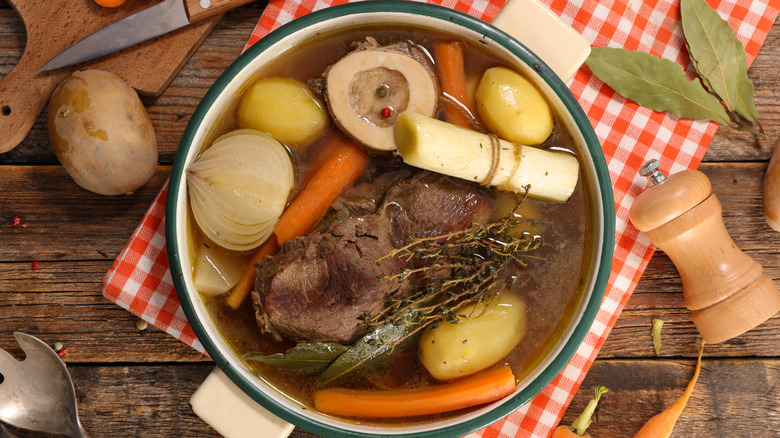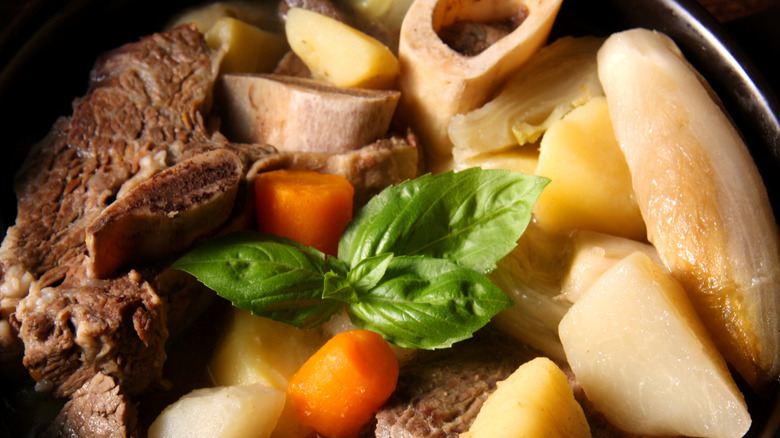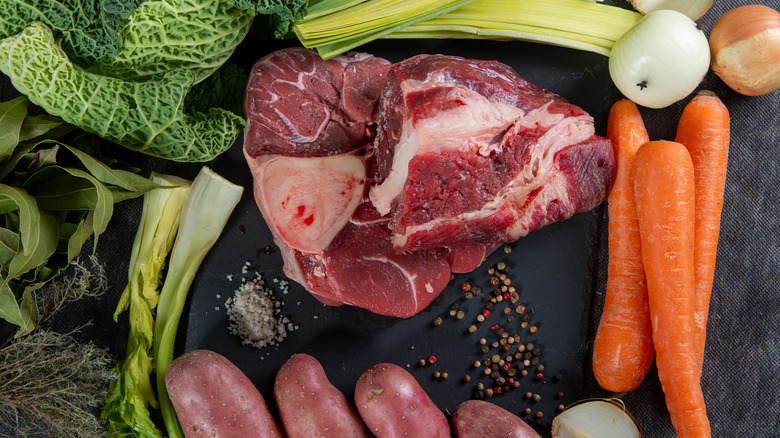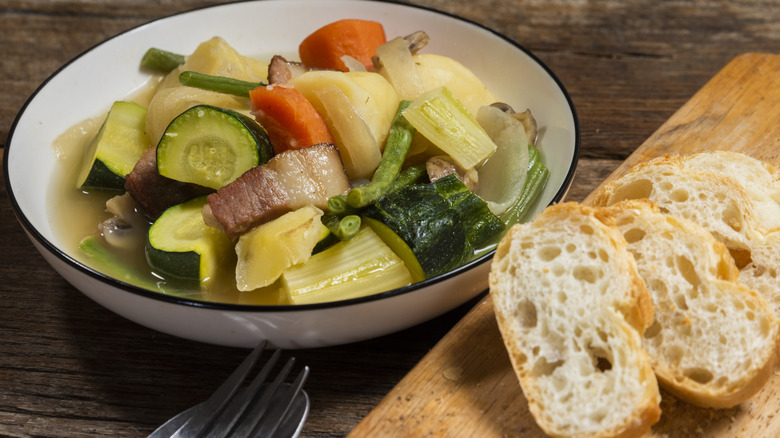Pot-Au-Feu, The French Beef Dish Meant To Feed A Crowd
Stews take time, and the required patience pays off diners with rich, highly aromatic flavors. This long-simmering method may seem intimidating for first-timers, but sticking with a time-tested technique will yield a delicious result.
Few stews have stood that test of time quite like pot-au-feu, which has been enjoyed for centuries. A well-loved classic in French cuisine, it marries varying cuts of meats with root vegetables, all slow-cooked to tender perfection in a delectable flavored broth.
And although it takes hours to prepare, pot-au-feu actually yields a multi-course meal for a crowd. There's a marrow-toast appetizer, a soup course, and a bountiful bowl of meat and vegetables to finish. Made with relatively low-cost ingredients all prepared in a single pot, it's savvy beef-based stew cooking at its best. No surprise then, that pot-au-feu has taken on a myriad of renditions in France. Let's see how this hearty and scrumptious dish came about.
Background of pot-au-feu
Now a favorite meal across France, pot-au-feu initiated from humble origins. Early precursors of the dish emerged in the Middle Ages, the long cooking designed to soften cheap cuts of meat alongside stale root vegetables. Its name — which translates to pot in the fire — refers to the ubiquitous cooking vessel at the time. Most houses contained a large hanging pot continuously heated atop a wood fire.
As famines swept France in the late 16th century, meat became less accessible, and the dish took hold with the aristocracy, who were the only ones who could afford the ingredients. During this time, it coined its name and gained its first mentions in print as a meal enjoyed by royalty. However, a set standard of technique was still absent, and the stew was still not ubiquitously enjoyed. Pot-au-feu only strongly established itself in French cuisine with the expansion of the middle class during the 18th century. Recipes started to appear in the 19th century, and, especially after World War II, pot-au-feu became an indispensable part of the culinary canon. Today, a version is found in nearly all classic French cookbooks.
What is in pot-au-feu?
Pot-au-feu's essence is in slow cooking a variety of components. The hearty stew traditionally uses beef bones, a few meat cuts — a larger assortment improves flavor — as well as a selection of root vegetables. Usually, the dish integrates cuts from the leg, like beef shank, as well as ribs, rump, and shoulder. The root vegetables include a shifting assortment of potatoes, carrots, onions, leeks, celery, and turnips. Many recipes add a bright flavor with fresh tomatoes or tomato paste. Plus, a bouquet garni is tossed in, tied with thyme, bay leaves, parsley, and sometimes rosemary.
As a classic dish encompassing all of France, there are multiple regional renditions. Across the country, ingredients can include everything from chicken sausage to pork, lamb, and more. Well-known deviations include pot-au-feu à la Bourguignon, which hails from Burgundy and fittingly incorporates red wine. Meanwhile, coastal versions, known as pot-au-feu de la mer, throw in the sea's freshest catch and shine with fish and shellfish. And pot-au-feu à la Provençale incorporates the local Meddietternean flavor of herbs de Provence. Slow-cooked for anywhere from an hour and a half to three hours, pot-au-feu's secret is in the slow melding of flavors.
How is pot-au-feu served?
Although cooked in a single pot, the dish results in two to three courses, which are all timed. The rarest — which only occurs when there are big beefy bones — is a toast topped with decadent bone marrow. The other two platings, which are more typical for pot-au-feu, come from separating the broth from the slow-cooked meats and vegetables.
Whenever the proteins and vegetables are cooked in pot-au-feu, they're only stewed until done and then removed from the liquid. At the very end of stewing, once all components are cooked to completion, the resultant broth is sieved, yielding a delicious, clear liquid. It's presented as the first course, often accompanied by bread.
Next, the prepared vegetables and meats are carved into smaller chunks and arranged on a plate. Sometimes, a mustard-based sauce using some of the broth is whisked up to accompany this. Another tasty option is to simply ladle a small amount of broth atop the slow-cooked components. A few cornichons add some tang, and some sprinkle parsley for color and fresh herby notes. Et voilà — the delicious stew is complete.



